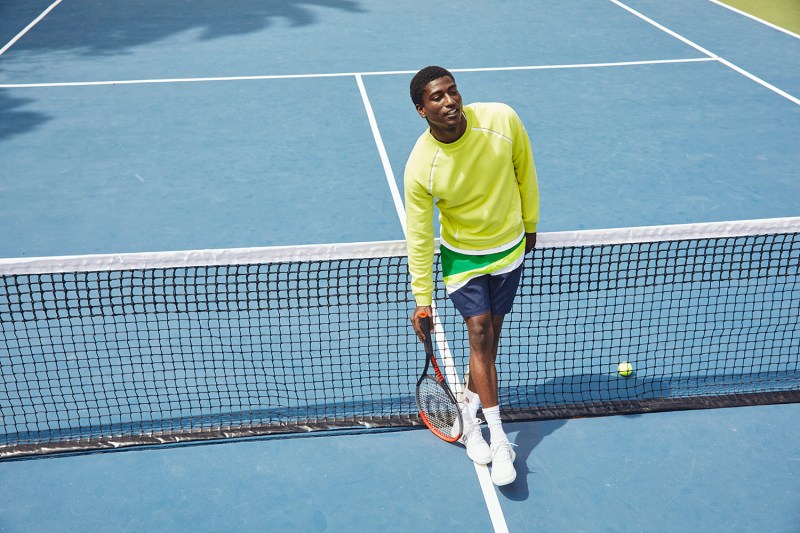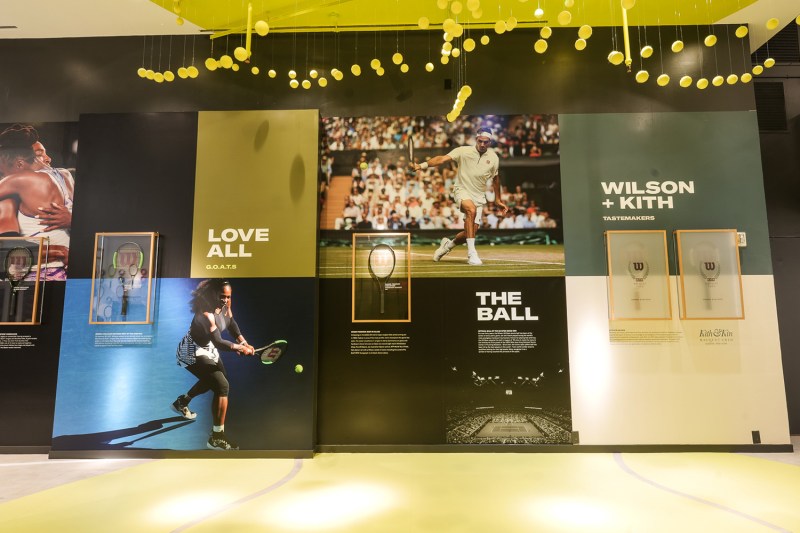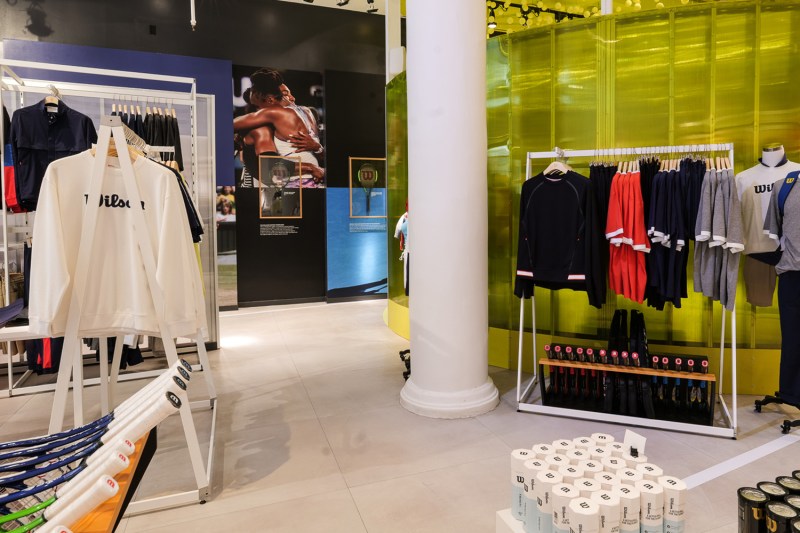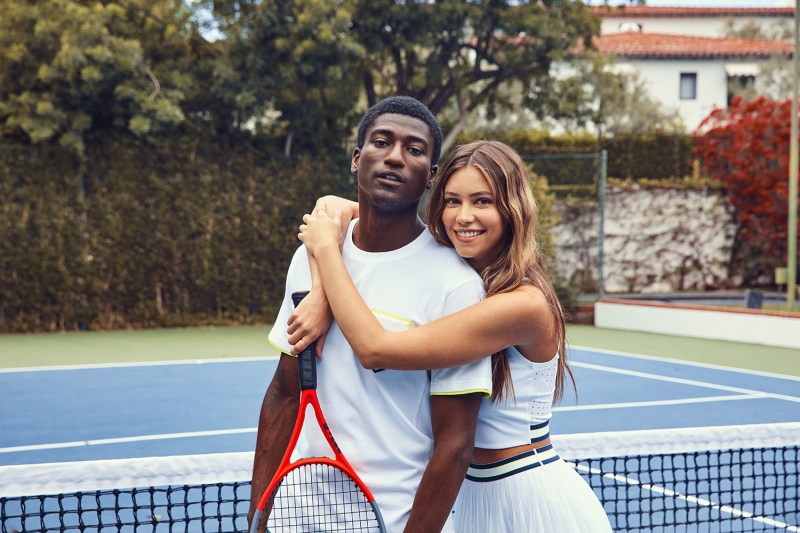
Broadway, in SoHo, is drab with gray sidewalks and brown rust, but there, under scaffolding, it shines like a chartreuse beacon: Wilson. With its trademark high-visibility yellow, which it introduced to tennis balls in 1972, the company has hung out its figurative shingle in front of its U.S. Open pop-up store in New York through September. The sign’s hue is more that just a bright spot in a muted cityscape; it’s symbolic: The store is open to everyone, as was the rationale behind the ball’s tint, which allowed TV audiences to track its travel more easily, increasing the sport’s watchability. One could even argue that this chromatic shift was a major contribution to the boom of the sport in the U.S. over the following two decades, leading to the ubiquity of the tennis court in American life.
Read More: Wilson Flagship Chicago Store Opening
History of Tennis in U.S.

Since its peak in the ’80s, tennis in the U.S. has not fared as well, and in years past, it would have been more accurate to describe a deserted tennis court as being as American as apple pie. Participation has been well down year after year as the sport and its domestic governing body, the U.S. Tennis Association (USTA), struggle with issues of perception and participation. That is, of course, until 2020. While a pandemic-swept U.S. was barred from its bar classes, boxed out of its boxes, and kicked out of its boot camps, a remarkable thing happened: More people than ever before started playing tennis.
According to the Physical Activity Council’s 2020 annual report, in which it surveys the eight largest sports trade associations, tennis participation was up 22%, with three million new players alone and almost four million one-time players returning to the courts. Digging into the numbers shows even better metrics for its future: 19.3% of Millennials and 22.4% of Gen Zs played a racquet sport in 2020, a percentage that, in some cases, doubled the participation numbers of older generations. (Think tennis is an old man’s sport? Not in 2020.)
“It’s evident that many people recognize tennis as the ideal social-distancing sport, which puts it in a great position to continue to grow and allow people to stay active and social in a healthy and safe manner,” crowed Mike Dowse, USTA CEO and executive director, in a release. He credited a united industry that had banded together to ensure the sport’s survival.
These are positive signs for a sport that has been bleeding out for decades. But if Dowse is quick to claim credit for the result despite the only discernible difference being a worldwide pandemic, then he could be left holding the bag should participation numbers recede in the coming years. The question is, therefore, how U.S. tennis can retain its myriad new players after the world returns to normal, and whether there’s any discernible effort to do so. It’s with these overarching questions in mind that I kicked around New York during the 2021 U.S. Open, the country’s oldest tennis tournament in its largest city.
The Wilson Kith Collaboration NYC Pop-Up Store

The Wilson pop-up, at first glance, seems to revel in the glory of the past. It leans hard into its century-long heritage (est. 1913) and the Open’s nearly 150-year history (est. 1881). Behind transparent cases, the company’s vintage racquets reside in airless, hushed spotlight: Jack Kramer’s from ’49, Billie Jean King’s from ’69. The Williams sisters and Roger Federer, who are all in their 40s or on the doorstep, all had signature models from years past (none played in this year’s tournament), while yellowed ads from the company’s early history hawk frames made from mahogany, cedar, walnut, and white ash, strung with real lamb’s gut.
But if you’re in the shop for more than 10 minutes, you see behind the dust of nostalgia to where the Now resides: A half-moon wall of chartreuse, with Wilson’s trademark balls of various diameters hanging in orbit while the gunshot snap of well-struck groundstrokes project from hidden speakers. It’s a popular social media location, and sure enough, several influencer-esque visitors capture selfies. Just before you reach the stairs, a display of Wilson’s Naked racquet series, introduced in 2021, and its Triniti balls, released in 2019, clearly show the direction of company. The limited-edition frame, while as effective as its regular edition, is made without paint, dyes, or one-use plastics while incorporating bio-based components. Triniti balls are designed with a rubber that extends their life while adding a more durable felt for longer play. Both come in recyclable packaging, a trifecta of the Three Rs you learned in grade school.
Upstairs, in a small seating area, stacks of Racquet magazines fan out. Launched in 2016 by former White House correspondent Caitlin Thompson and international journalist David Shaftel, the quarterly magazine is printed on a thick, matte paper (FSC-certified and carbon-neutral, bien sur), it tells stories about tennis’s present and past in a way that, frankly, is a hell of a lot more compelling than anything I’ve previously read on the sport. Issue 16, released in the spring, includes a feature on Australian iconoclast Nick Kyrgios, who once claimed he’d lost a match because he couldn’t see after playing video games too late the night before. The issue’s lead essay, by writer Andrew Eccles, uses its thousand or so words to argue that the 2021 French Open commemorative poster is gay, and tennis is gay, and that is very, very good. (It’s a bold stretch.)
“We can do whatever we want,” Thompson says of the essay in question and the magazine itself. Racquet epitomizes this new boom of tennis players, and it’s because both founders grew up playing tennis tennis not at a country club sport but on the public courts, where it felt “democratized, cool, rebellious.”
“People are looking for a way in [to tennis],” she continues, “and I don’t think they’ve always felt spoken to.”
Everything is up for Racquet in the last 18 months: It has doubled its subscribers, social media followers, and web traffic. It may be, in part, because Thompson isn’t hiring dyed-in-the-wool tennis writers, photographers, or designers. Instead, she’s recruiting contributors who excel at their craft but aren’t the most core with tennis. She and her co-founder can fill in any glaring gaps, but these fresh eyes tell stories that veteran tennis journos have had all but bludgeoned out of them over the decades. “You think [the White House Press Pool is] an old, white, male demographic, and then you go into a sports media center,” she says. “Of course this sport has not innovated.”
With all that she sees as wrong with the sport in the U.S., Thompson isn’t as easily steer toward what she feels are the bright spots. But they’re there. Rather than a hegemonic two or three companies owning the entire pie of tennis soft- and hardgoods, more and more small businesses have sprung up in the past few years. Heritage brands like Ellesse, Fila, and Sergio Tacchini are reinvigorated; new businesses are popping via social media, like Furi Sport, a racquet company out of Brooklyn that was founded by a first-generation Haitian-American. A cottage industry is finding a market.
Wilson Sportswear Line

Thompson feels that there’s no better example than Wilson itself, which launched an athleisure Sportswear line in Spring ’21 as well as a tennis capsule with Kith for the hypebeasts in the late summer. “Wilson is a great example of a modern brand reinvigorating and reclaiming what’s cool about tennis and tennis style,” she says.
On the first of the U.S. Open, my wife and I watch next-gen stars in their first-round matchups. Coco Gauff dispatches some poor Pole in straight sets, while Naomi Osaka, the highest-paid woman athlete in 2020, shows a Czech the magical realism of her punishing groundstrokes. But the headliner of the night is between eventual tournament winner Daniil Medvedev, 25, and 35-year-old Richard Gasquet. It seemed like a fitting symbolism for the past 18 months, in which a new generation flooded into the sport and may decide its future. Medvedev dismantled the Frenchman in straight sets that went into the small hours of the morning; Medvedev would ultimately march through world number-one Novak Djokovic, 34, a day shy of two weeks later. Something fresh seems to be happening in tennis, from the grassroots through the pros.
Back home, in Nashville, I can’t say that I answered my question of how U.S. tennis will retain its surplus of new players. If there’s one thing for certain with national governing bodies and B-tiered sports, it’s that they will squander any opportunity while attempting to enshrine themselves and their power. But I know that, at the very least, I will keep playing. On Saturday morning, I’ll don my Kith warmups, grab my Wilson racquet, and meet my partner on the courts for an hour or two of match play. We met recently on a Facebook tennis group. He’s just getting back into the sport after a long layoff. But he’s catching on fast.



